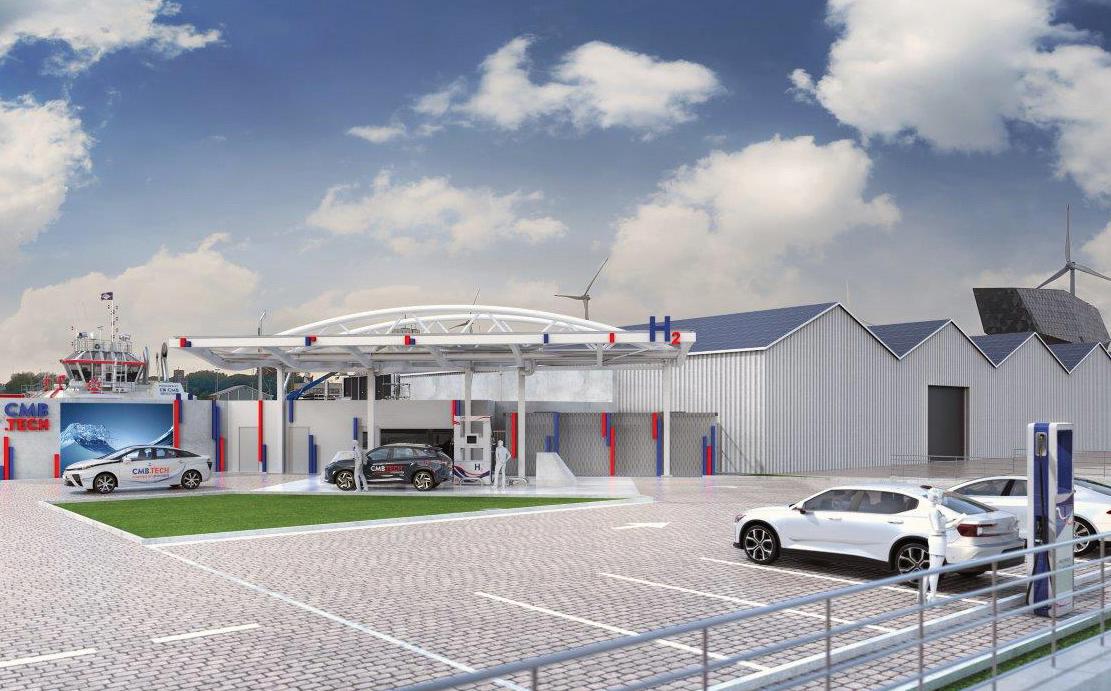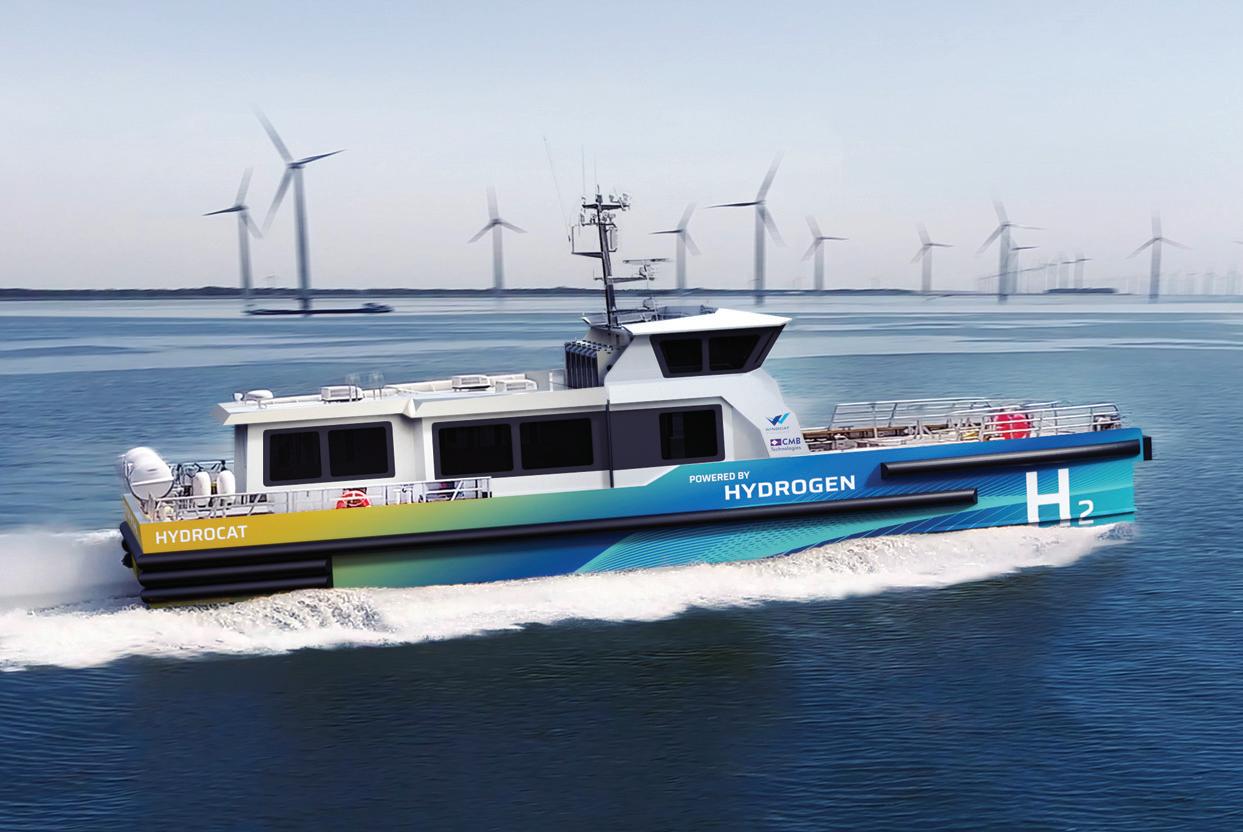
6 minute read
Vessels
PIONEERING HYDROGEN MARINE POWER
A pioneer in the field of hydrogen power for shipping is equipping a major European port with both vessels and infrastructure so it can embrace the eco-friendly fuel, writes Anne-Marie Causer
Compagnie Maritime Belge (CMB), is behind the pioneering hydrogen powered Hydroville ferry shuttle and forthcoming Hydrotug at the Port of Antwerp.
In 2017, the Antwerp-based shipping group's Hydroville shuttle, the first passenger vessel to be powered by hydrogen, was launched as a pilot project to serve as a testbed for hydrogen technology on a wider scale. The vessel currently serves as a sustainable commuter transport within the port area.
“Hydroville was the first class approved passenger ferry which is powered with two dual fuel hydrogen-diesel drive trains. The vessel acts as a kind of icebreaker for the use of hydrogen in the marine industry, says Roy Campe, managing director of CMB.TECH.
GROUND-BREAKING
Since its launch, Mr Campe says that Hydroville has proved that the technology is mature and ready to scale up to achieve more hydrogen storage, higher pressures, more power and cater for bigger ships.
Besides the construction of the vessel and integration of the H2 technology, knowledge has also been gained about the operation, bunkering and maintenance of the vessel, setting a benchmark for the other hydrogen powered vessels which are now in the pipeline.
“Making the energy transition is not like flipping a light switch, it needs pilot projects to demonstrate the technology before the upscaling can be done,” says Mr Campe.
For now, the test phase of Hydroville involves regular checks on the lub oil of the engines to monitor the long-term effect of the hydrogen combustion.
Also, the hydrogen storage with all its pipes and valves needs a full check up every three months.
So far, all results are very promising with the green light to further roll out the use of this promising technology, Mr Campe says.
With regards to refuelling, CMB.TECH is currently constructing a public and maritime hydrogen refuelling station expected to be completed in June 21 (as this article goes to press).
Until then, a tube trailer is being used to bunker the vessel.
The full operation of connecting the trailer to CMB.TECH's H2 bunkering manifold at the quayside and the refill of the vessel takes about half an hour.
With the new refuelling station, refuelling time should be halved as the delivery pressure is much higher.
HYDROTUG
CMB.TECH is currently developing and building a hydrogen powered tugboat for the Port of Antwerp.
The Hydrotug is the first vessel with output in the 4000 kW class to be powered by hydrogen-diesel dual fuel.
It's driven by combustion engines that burn hydrogen in combination with diesel. The motors also comply with the very strictest standard, the EU Stage V, making them the lowest rated for emissions on the market.
BeHydro medium speed engines will be used to power the vessel along with two 2MW medium speed engines which are able to run up to 85% of hydrogen in combination with Stage V after treatment.
The tug is scheduled to be completed sometime towards the
Although the effect on the current emissions at the port from Hydroville is almost negligible, the rebound effects from the pilot will be significant, both to new vessels being built and the equipment on the land side.
With regards to infrastructure port side, Mr Campe says that the company is working on new projects which will have a much larger effect on the local emissions of the port.
8 The hydrogen refuelling station is expected to be completed in
June 21
8 The 80-passenger
ferry Hydrocat will be launched in Japan


Photo: CMB.TECH
latter part of 2022. Meanwhile CMB has teamed up with the Ghent-based engine builder ABC to set up the BeHydro joint venture with the aim of further developing the hydrogen technology for medium-speed engines with higher power output and with mono fuel spark ignited engines.
ENERGY PIONEER
With the Hydroville and the Hydrotug vessels at the Port of Antwerp, CMB is already affirming its international pioneering role in the transition of ships to hydrogen.
But it also has more international projects in the pipeline.
In May an 80-passenger ferry called the HydroBingo will be launched in Japan.
Later this year a H2 powered CTV called the Hydrocat will be launched in the Netherlands.
This vessel is a H2 powered CTV and two 1200hp engines and 200kg of hydrogen storage at 350bar and will be operated by the CMB subsidiary Windcat Workboats.
CMB says that other vessels such as a pilot vessel, coaster and inland water barges will be announced in the near future.
Mr Campe also tells GreenPort that CMB.TECH is working on four other applications which are used within the terminal environment of the port. These projects will also be announced in due course.
The future is bright for hydrogen, Mr Campe says, especially when it's deployed in the hydrogen powered vessels of the future.
Port areas will be the first local hotspots for hydrogen power. Both on the supply and production of the clean fuel, but also on the applications which will run on hydrogen.
“Especially for the heavy-duty applications, hydrogen dual fuel solutions can offer some crucial advantages compared to other clean technologies,” says Mr Campe.
“These advantages include quick refuelling and realistic autonomy while offering the emission reduction at an affordable cost.”
Ports, he says, represent a very dense area of users which are suitable to be converted with a dual fuel technology.
Once the hydrogen supply is established, the emission savings can be huge while still offering a strong business case for the users.
8 The 80-passenger ferry HydroBingo will be launched in Japan
The case for hydrogen
Hydrogen has an important role to play in the transition to renewable energy mix, its advocates argue.
Through electrolysis, it is possible to produce hydrogen by using excess power, then store it and reuse it in the future near the end user.
Hydrogen allows storing energy in chemical form that can be used in internal combustion engines or in fuel cells to generate power with only water and heat as by products.
What's more, when all the elements of the cycle of renewable hydrogen are working together it becomes a closed loop cycle and CO2 neutral.
Critics say though that although hydrogen has a place in the marine fuel mix, there are still problems to overcome and it may not be suitable for all vessel types.
For larger ships with a long sailing range, the space needed to store the fuel is the biggest hurdle. Storage in a liquified state is possible but more complicated.
For ferries and other vessels at shorter distances, hydrogen is more feasible, but there is the issue of periods of low or no activity to tackle. In a refrigerated tank, hydrogen begins to 'boil off' and must then either be vented or reliquefied.
Another issue that needs to be overcome are the issues of hydrogen embrittlement and diffusion to marine diesel engines.
Going forward, hydrogen used needs to be produced in a sustainable way. Currently around 95% of all production is 'brown' hydrogen which is extracted from fossil fuels.










